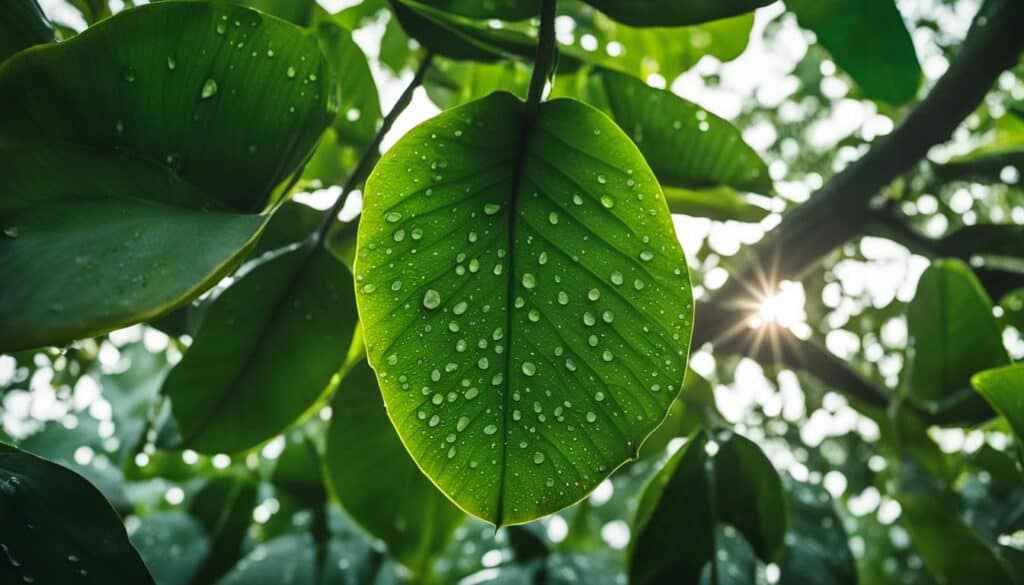As a professional journalist, I am thrilled to share with you the wonders of the world’s biggest fruit tree – the jackfruit. Native to South India, this massive fruit tree is a true marvel of nature. Not only is it the largest tree-borne fruit in the world, but it also holds immense cultural significance and offers a plethora of culinary and health benefits.
The jackfruit, scientifically known as Artocarpus heterophyllus, is a giant among fruit trees. Its fruit can grow to enormous sizes, earning it the titles of “colossal,” “gigantic,” “humongous,” and “mammoth.” But there’s more to this tree than just its impressive size.
Key Takeaways:
- The jackfruit is the world’s largest tree-borne fruit, native to South India.
- Every part of the jackfruit tree and fruit is useful, from wood to leaves.
- Jackfruit is rich in vitamins, minerals, antioxidants, protein, and fiber.
- The fruit is used in various culinary dishes, both raw and ripe, in South Indian cuisine.
- Jackfruit holds cultural significance and is celebrated in festivals and celebrations in India.
The Nutritional Value of Jackfruit
Jackfruit is not only a delicious and versatile fruit but also a powerhouse of nutrients. Let’s dive into the nutritional value of jackfruit and explore the health benefits it offers.
One of the key nutritional highlights of jackfruit is its high vitamin C content. A single serving of jackfruit provides a significant amount of this essential antioxidant, which plays a crucial role in boosting the immune system and fighting off free radicals that can cause cellular damage.
Jackfruit is also rich in various minerals, including potassium, magnesium, and iron. Potassium helps regulate blood pressure, magnesium supports bone health, and iron is essential for oxygen transport in the body.
The fiber content in jackfruit is another notable aspect of its nutritional profile. Fiber aids in digestion, promotes a healthy gut, and helps maintain a feeling of fullness, making it a great addition to a balanced diet.
| Nutrient | Amount per 100g |
|---|---|
| Vitamin C | 13.8mg |
| Potassium | 303mg |
| Magnesium | 37mg |
| Iron | 0.6mg |
| Fiber | 1.5g |
In addition to these essential nutrients, jackfruit also contains antioxidants that help protect the body against oxidative stress and inflammation. These compounds may have potential health benefits, such as reducing the risk of chronic diseases.
With its impressive nutritional profile, jackfruit is not only a tasty treat but also a valuable addition to a healthy and balanced diet. So, next time you enjoy a serving of jackfruit, savor its delicious flavor while reaping the benefits of its incredible nutritional value.
Culinary Uses of Jackfruit

When it comes to culinary creativity, jackfruit offers countless possibilities. Its unique taste and texture make it an ideal ingredient for a variety of dishes. From savory curries to crispy chips and delectable desserts, here are some popular jackfruit recipes to try:
Jackfruit Curry
One of the most beloved ways to enjoy jackfruit is in a flavorful curry. The tender and meaty texture of the fruit pairs well with aromatic spices and creamy coconut milk. Jackfruit curry is often prepared with a blend of spices like turmeric, cumin, and coriander, along with onions, ginger, and garlic. This hearty dish can be served with rice or roti for a satisfying meal.
Jackfruit Chips
If you’re a fan of crispy snacks, jackfruit chips are a must-try. Made from thinly sliced jackfruit, these chips are deep-fried to perfection and seasoned with spices like salt, chili powder, and turmeric. They offer a delightful combination of crunchy texture and subtle sweetness. Jackfruit chips are a popular snack in many South Indian households and are perfect for munching on during movie nights or gatherings.
Jackfruit Desserts
Ripe jackfruit lends itself beautifully to delectable desserts. Its naturally sweet and fragrant flavor adds a unique twist to traditional sweets. Ripe jackfruit is often used to make payasam, a creamy and aromatic dessert prepared with milk, jaggery or sugar, and flavored with cardamom. It can also be used to make halwa, a rich and dense sweet dish made with ghee, sugar, and nuts. Jackfruit’s natural sweetness can be a delightful addition to pancakes, fritters, and cakes as well.
| Jackfruit Recipe | Ingredients | Preparation Time |
|---|---|---|
| Jackfruit Curry | Jackfruit, coconut milk, spices, onions, ginger, garlic | 40 minutes |
| Jackfruit Chips | Jackfruit, salt, chili powder, turmeric | 1 hour |
| Jackfruit Payasam | Ripe jackfruit, milk, jaggery or sugar, cardamom | 30 minutes |
These are just a few examples of the culinary delights that can be created with jackfruit. Whether you’re a fan of savory dishes or have a sweet tooth, exploring the diverse range of jackfruit recipes will surely leave you impressed.
The Versatility of Jackfruit in South Indian Cuisine
When it comes to South Indian cuisine, jackfruit takes center stage with its incredible versatility and unique flavors. From savory dishes to sweet treats, jackfruit is a beloved ingredient that adds a distinctive touch to a variety of dishes.
One popular way to enjoy jackfruit in South Indian cuisine is through jackfruit dosas. These pancakes are made from fermented jackfruit batter, which gives them a tangy and slightly sweet taste. Jackfruit dosas are often served with chutney or sambar, a flavorful lentil soup.
Another popular dish is jackfruit papad, a crispy and savory snack made from dried jackfruit pulp. The papads are seasoned with spices and herbs, then deep-fried to perfection. They are often enjoyed as an appetizer or accompaniment to a meal.
| Jackfruit in South Indian Cuisine | Jackfruit Festivals in India | Jackfruit Dosas | Jackfruit Papad |
|---|---|---|---|
| Curries | Food festivals dedicated to jackfruit | Fermented jackfruit batter | Dried jackfruit pulp |
| Chips | Coastal towns celebrations | Tangy and slightly sweet | Seasoned with spices and herbs |
| Desserts | Traditional meals during auspicious occasions | Served with chutney or sambar | Deep-fried to perfection |
Jackfruit in South Indian cuisine offers a wide array of culinary experiences, from rich and flavorful curries to crispy and savory snacks. Its versatility and unique taste make it a staple in many households and a highlight of festivals and celebrations throughout India.
Exploring the versatility of jackfruit in South Indian cuisine allows us to appreciate the rich cultural heritage and culinary traditions of the region. Whether it’s the tangy dosas or the crispy papads, jackfruit adds a delightful twist to every dish it graces.
So next time you’re looking to try something new and exciting in the kitchen, consider incorporating jackfruit into your recipes. You’ll be able to experience the flavors of South India and discover the endless possibilities that this remarkable fruit has to offer.
The Health Benefits of Jackfruit Leaves

Jackfruit leaves not only contribute to culinary delights but also offer a range of health benefits. These leaves have long been utilized in traditional medicine for their therapeutic properties. They contain compounds with antioxidant, anti-inflammatory, and antimicrobial effects, making them valuable in maintaining overall well-being.
In traditional medicine, jackfruit leaves are often used to alleviate toothache. The leaves are chewed or made into a paste and applied to the affected area for natural pain relief. They are believed to possess analgesic properties that help soothe dental discomfort.
Furthermore, jackfruit leaves have been used to manage various health conditions, including ulcers and diabetes. Their high fiber content aids in digestion, while their ability to regulate blood sugar levels can be beneficial for individuals with diabetes. Additionally, these leaves are rich in calcium, which strengthens bones and may help prevent osteoporosis.
Jackfruit leaves are a treasure trove of health benefits. Their medicinal properties have been recognized and utilized for generations, making them an integral part of traditional medicine. From relieving toothache to managing diabetes, these versatile leaves offer natural remedies for various ailments.
Table: Health Benefits of Jackfruit Leaves
| Health Benefit | Description |
|---|---|
| Relieves Toothache | The leaves can be chewed or made into a paste and applied to the affected area for natural pain relief. |
| Manages Diabetes | Jackfruit leaves help regulate blood sugar levels, making them beneficial for individuals with diabetes. |
| Heals Ulcers | The leaves possess antimicrobial properties that can help in the management of ulcers. |
| Strengthens Bones | Rich in calcium, jackfruit leaves contribute to strong and healthy bones, potentially preventing conditions like osteoporosis. |
| Antioxidant Effects | The leaves contain antioxidants that help protect against oxidative stress and promote overall well-being. |
The World’s Largest Cashew Tree

While discussing the magnificence of the world’s biggest fruit tree, it is worth mentioning another notable giant in the botanical world – the cashew tree. Located in Brazil, this extraordinary cashew tree has earned itself a place in the Guinness World Records as the largest of its kind. Covering an astonishing two acres, its sprawling branches stretch up to 164 feet from the central trunk. Thanks to genetic mutations causing sideways growth and the establishment of new sets of roots, this tree boasts a mini forest-like appearance that attracts tourists from near and far.
The impressive size of the cashew tree is truly a remarkable sight to behold. Its sheer scale and sprawling branches create a captivating visual experience, making it a favorite subject for photographers and social media enthusiasts. The tree’s distinctive mini forest appearance offers a unique perspective on the grandeur of nature and reminds us of the awe-inspiring diversity of the plant kingdom.
| Table: World’s Largest Cashew Tree in Brazil | |
|---|---|
| Location | Brazil |
| Area Covered | 2 Acres |
| Branch Spread | Up to 164 feet |
| Description | Giant cashew tree with mini forest-like appearance |
Visiting the largest cashew tree in Brazil is a unique experience that allows us to appreciate the wonders of nature. It serves as a reminder of the incredible diversity and beauty that can be found in the world’s plant life, and the importance of preserving and protecting these natural wonders for future generations to enjoy.
References:
- Guinness World Records
- Brazilian Tourism Board
- Nature Conservation Organizations
The Significance of the Phoenix Palm Tree in Saudi Arabia
The Phoenix Palm Tree, also known as the Date Palm, holds immense cultural and historical value in Saudi Arabia. As the national tree of the country, it is a revered and iconic symbol of Saudi Arabian heritage. The Phoenix Palm Tree has been cultivated in the region for thousands of years and plays a significant role in the daily lives of the people.
One of the primary uses of the Phoenix Palm Tree is as a source of food. The tree produces dates, which are a staple in Saudi Arabian cuisine. Dates are used in a variety of dishes, desserts, and beverages, and they hold cultural and religious significance. The sweetness and richness of dates make them a delightful treat that is enjoyed by people of all ages.
Beyond its culinary importance, the Phoenix Palm Tree is deeply rooted in Saudi Arabian culture. It is utilized in various traditional practices and ceremonies. The leaves of the tree are used to make baskets, mats, and other woven products. The wood is highly valued for furniture making, and the sap is used for making vinegar, soap, and alcoholic beverages. The tree is also mentioned in the Quran, further underscoring its cultural and religious significance.
| Key Facts about the Phoenix Palm Tree |
|---|
| The Phoenix Palm Tree is the national tree of Saudi Arabia. |
| It is cultivated for its dates, which are a staple in Saudi Arabian cuisine. |
| The leaves of the tree are used to make baskets and mats. |
| The wood is highly valued for making furniture and construction materials. |
| The sap of the tree is used to make vinegar, soap, and alcoholic beverages. |
The Phoenix Palm Tree’s enduring presence in Saudi Arabian culture and its contributions to various aspects of life make it a treasured and respected symbol of the nation’s rich heritage. Whether enjoyed as a delicious fruit or utilized in traditional practices, the Phoenix Palm Tree stands as a testament to the harmony between nature and culture in Saudi Arabia.
The Physical Characteristics of the Phoenix Palm Tree

The Phoenix Palm Tree, also known as the Date Palm, is a majestic tree that possesses distinct physical characteristics. Standing tall at heights of up to 30 meters, it commands attention with its impressive presence. The trunk of the Phoenix Palm Tree is slender, adorned with unique leaf scars that serve as vibrant reminders of its growth. The most striking feature of this tree is its long, elegant fronds that can reach lengths of up to 6 meters. These fronds sway gracefully in the breeze, creating a mesmerizing sight.
The leaves of the Phoenix Palm Tree are arranged in a feather-like pattern, consisting of numerous small leaflets. This arrangement not only adds to the tree’s aesthetic appeal but also assists in the efficient capture of sunlight for photosynthesis. Furthermore, the Phoenix Palm Tree produces delicate clusters of small yellow flowers, which eventually develop into the iconic date fruit that is cherished in Saudi Arabia and beyond.
The Height and Fronds of the Phoenix Palm Tree
As previously mentioned, the Phoenix Palm Tree can reach towering heights of up to 30 meters. This impressive stature makes it a prominent feature in the landscapes of Saudi Arabia, where it is widely cultivated. The tree’s magnificent fronds, extending up to 6 meters in length, create a striking silhouette against the sky. These fronds are characterized by their feathery appearance, composed of beautifully arranged leaflets that add to the tree’s grandeur.
The impressive height and elegant fronds of the Phoenix Palm Tree contribute to its symbolic significance in Saudi Arabian culture and its reputation as an iconic tree. It epitomizes the resilience and adaptability of plant life in arid regions and stands as a testament to the rich heritage and natural beauty of Saudi Arabia.
Cultivation and Uses of the Phoenix Palm Tree
When it comes to cultivating the majestic Phoenix Palm Tree, specialized knowledge and skills are required. The propagation of this iconic tree is typically done through seedlings, which are carefully nurtured to ensure proper growth. The Phoenix Palm Tree thrives in well-drained, fertile soil and requires regular maintenance activities such as pruning, watering, and pest control. Its deep-reaching roots and ability to store water in its trunk and fronds make it well-adapted to the arid conditions of Saudi Arabia, allowing it to survive during droughts.
Aside from being a source of food, the Phoenix Palm Tree has diverse uses in Saudi Arabia. Its long, elegant fronds are commonly used to make baskets and mats, showcasing the craftsmanship and cultural heritage of the region. In addition, the wood of the Phoenix Palm Tree is highly valued and used in furniture making and construction materials. The sap of the tree has various applications and is used to produce vinegar, soap, and even alcoholic beverages.
| Uses of the Phoenix Palm Tree in Saudi Arabia | Examples |
|---|---|
| Baskets and Mats | Handwoven baskets and mats made from the fronds of the Phoenix Palm Tree are used for storage, decoration, and traditional ceremonies. |
| Furniture | The durable and beautiful wood of the Phoenix Palm Tree is utilized in the crafting of furniture pieces such as chairs, tables, and cabinets. |
| Construction Materials | The strong and resilient trunk of the Phoenix Palm Tree is used in the construction industry for beams, poles, and other structural elements. |
| Traditional Crafts | The leaves, fronds, and other parts of the tree are used in various traditional crafts, including weaving, thatching, and sculpture. |
The Phoenix Palm Tree holds cultural and religious significance in Saudi Arabia and is mentioned in the Quran. Its versatile uses and ability to thrive in harsh environments make it a cherished and respected tree in the region.
With its remarkable cultivation and diverse applications, the Phoenix Palm Tree stands as an emblem of the rich cultural heritage and ingenuity of the people of Saudi Arabia.
References:
- “The Phoenix Palm (Date Palm) – The Tree of Life,” Saudi Arabian Cultural Mission – Cultural Division.
- “The Date Palm Tree – Symbol of Saudi Arabia,” My Saudi Trips.
- “Phoenix dactylifera,” IUCN Red List of Threatened Species.
Conservation Efforts for the Phoenix Palm Tree

In recent years, conservation efforts for the Phoenix Palm Tree in Saudi Arabia have gained significant traction. The importance of protecting this iconic symbol of the country’s cultural heritage has been recognized, leading to measures aimed at preserving and safeguarding the tree and its habitat.
To ensure the survival of the Phoenix Palm Tree, the Saudi Arabian government has implemented various initiatives. One such effort involves the planting of new trees across the country, replenishing and expanding the population of these magnificent palms. Additionally, existing trees are closely monitored to identify and address any potential threats or diseases that could harm their health.
Education plays a crucial role in raising awareness about the importance of the Phoenix Palm Tree and the need for its conservation. Public campaigns and outreach programs have been launched to inform the population about the significance of the tree and the measures being taken to protect it. By fostering a sense of stewardship among the people, these initiatives aim to promote a culture of environmental responsibility and care.
The Phoenix Palm Tree now enjoys legal protection under Saudi Arabian law, ensuring that those who violate conservation regulations face penalties. This legal framework emphasizes the importance of preserving the tree and serves as a deterrent against actions that could harm its population and habitat.
Through these collective efforts, the conservation of the Phoenix Palm Tree in Saudi Arabia has made significant progress. By valuing and protecting this unique species, the country is not only safeguarding its cultural and natural heritage but also contributing to the global conservation of biodiversity.
| Conservation Effort | Description |
|---|---|
| Planting New Trees | The government is actively planting new Phoenix Palm Trees across Saudi Arabia to increase their population and expand their habitat. |
| Monitoring and Disease Control | Existing trees are closely monitored for any signs of diseases or threats, and appropriate measures are taken to mitigate these risks. |
| Educational Campaigns | Public awareness programs and campaigns have been launched to educate the population about the importance of the Phoenix Palm Tree and its conservation. |
| Legal Protection | The Phoenix Palm Tree is now a protected species under Saudi Arabian law, ensuring legal penalties for violations of conservation regulations. |
Conclusion
In conclusion, the jackfruit stands proudly as the world’s largest fruit tree, captivating us with its grandeur and versatility. This magnificent tree, native to South India, offers not only a delicious and unique taste but also a wide range of culinary possibilities. From savory curries and chips to indulgent desserts, the jackfruit proves itself to be a culinary gem.
On the other hand, we cannot overlook the significance of the Phoenix Palm Tree, known as the national tree of Saudi Arabia. With its towering presence and graceful fronds, this majestic tree has been an integral part of Saudi Arabian culture for thousands of years. It provides sustenance through its delicious dates, and its leaves and wood are used in various crafts and constructions.
While the jackfruit enchants us with its culinary offerings, the conservation of the Phoenix Palm Tree is of utmost importance. With habitat loss and other threats looming, efforts are being made to protect this iconic species. Conservation initiatives aim to safeguard the Phoenix Palm Tree and its habitat, ensuring its survival for generations to come.
Both the jackfruit and Phoenix Palm Tree captivate us with their immense size, cultural significance, and contributions to the world. Whether we savor the culinary delights of the jackfruit or cherish the traditions surrounding the Phoenix Palm Tree, these remarkable trees remind us of the beauty and wonder of the natural world.
FAQ
What is the nutritional value of jackfruit?
Jackfruit is rich in vitamins, minerals, antioxidants, protein, and fiber. It is an excellent source of vitamin C and contains a wide range of B complex vitamins. The fruit also provides important minerals like potassium, magnesium, and iron.
What are the culinary uses of jackfruit?
Jackfruit is incredibly versatile in the kitchen. In South Indian cuisine, it is commonly used to make curries, chips, fritters, and dumplings. The ripe fruit is also delicious on its own or made into desserts like payasam and halwa.
How is jackfruit used in South Indian cuisine?
Jackfruit is an integral part of South Indian cuisine. It is used in various dishes, including curries, dosas, papads, and traditional meals during festivals and auspicious occasions.
What are the health benefits of jackfruit leaves?
Jackfruit leaves have various health benefits. They are rich in calcium and are known to have a positive impact on toothache, ulcers, diabetes, and osteoporosis. Compounds found in jackfruit leaves are also believed to have antioxidant and anticancer properties.
Where is the world’s largest cashew tree located?
The world’s largest cashew tree is located in Brazil. It covers an astounding two acres and is recognized by Guinness World Records.
What is the significance of the Phoenix Palm Tree in Saudi Arabia?
The Phoenix Palm Tree, also known as the Date Palm, holds great significance in Saudi Arabia. It is the national tree of the country and has been cultivated for thousands of years. It is used as a source of food and is involved in various cultural and religious practices.
What are the physical characteristics of the Phoenix Palm Tree?
The Phoenix Palm Tree can reach heights of up to 30 meters. It has a slender trunk covered in leaf scars and long, elegant fronds that can grow up to 6 meters in length. The leaves are arranged like a feather, with many small leaflets.
How is the Phoenix Palm Tree cultivated and used in Saudi Arabia?
The Phoenix Palm Tree is propagated through seedlings and requires well-drained, fertile soil. It is used as a source of food, and its leaves are utilized to make baskets and mats. The wood of the tree is also used in furniture and construction materials. The sap of the tree is used to make various products like vinegar, soap, and alcoholic beverages.
What conservation efforts are in place for the Phoenix Palm Tree?
The Phoenix Palm Tree is a protected species in Saudi Arabia. The government has implemented measures to protect the tree and its habitat, including planting new trees, monitoring existing ones, and educating the public about its importance. Violators of conservation regulations can face penalties under Saudi Arabian law.
Source Links
- http://rashminotes.com/2020/06/17/jackfruit-discover-the-versatality-of-the-largest-tree-borne-fruit-in-the-world/
- https://www.dailymail.co.uk/travel/travel_news/article-8278195/The-worlds-largest-cashew-tree-covers-two-acres-park-Brazil-looks-like-mini-forest.html
- https://www.shajara.ae/discover-the-majesty-of-the-phoenix-palm-tree-national-tree-of-saudi-arabia/





Leave a Reply